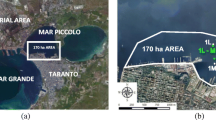Abstract
Experimental tests have been carried out on the sediments in order to obtain these geotechnical and environmental properties. The sediments studied present loamy nature, high plasticity, and low swelling potential with a capacity to immobilize the organic and inorganic pollutants. The sediments studied are contaminated by the organic matter and in heavy metals. The environmental behavior proves the immobility of heavy metals in the sediments. The valuation of the sediments is possible while taking into account its nature and these plastic properties.
Access this chapter
Tax calculation will be finalised at checkout
Purchases are for personal use only
Similar content being viewed by others
References
Geode. Metals and polychlorinated biphenyls (PCBs) in dredged sediments in the French ports: evolution 1986–1993; 1996. 72 p.
OMMP (Office of the Merchant Marine and Ports). Annual Report; 2004. 46p.
Order of 08/01/98 laying down the technical requirements applicable to the sludge spreading on agricultural soils taken in application of decree n° 97-1133 of 08/12/97 relating to the spreading of the sludges resulting from the treatment of the waste water.
Particle size analysis—laser diffraction methods—Part 1: General principles.
Plassard F, Winiarski T, Petit-Ramel M. Retention and distribution of three heavy metals in a carbonated soil: comparison between batch and unsaturated column studies. J Contam Hydrol. 2000;42:99–111.
Schumacher BA. Methods for the determination of total organic carbon (TOC) in soils and sediments. United States Environmental Protection Agency Environmental science National Division; 2002. 25 p.
Snethen DR. Expansive soil in highway subgrades. Report FHWA-TS-80-236; 1980.
Segura R, Arancibia V, Zúniga MC, Pasten P. Distribution of copper, zinc, lead and cadmium concentrations in stream sediments from the Mapocho River in Santiago. Chile J Geochem Explor. 2005;91:71–80.
Yong RN, Warkentin BP, Phadangchewit Y, Galvez R. Buffer capacity. 1990;53:53–67.
Yukselen Y, Kaya A. Suitability of methylene blue for surface area, cation exchange capacity and swell potential determination of clayey soils. Eng Geol. 2008;102:38–45.
NF P 94-051. Soils: recognition and testing—determination of boundaries of Atterberg—liquidity limit at cup—roll plasticity limit. AFNOR; 1993. 14 p.
NF P 94-048. Soils: recognition and testing—determination of Carbonate—Calcimeter method. AFNOR; 1996. 12 p.
NF P 94-068. Soils: reconnaissance and testing—measurement of capacity adsorption of methylene blue from soil or rock material. AFNOR; 1998. 9 p.
NF EN 12457-3. Waste characterization—leaching—compliance testing for leaching of fragmented waste and sludge—Part 3: double-sheeted test with a liquid-solid ratio of 2 l/kg and 8 l/kg for materials with a high content of solid and granularity less than 4 mm (without or with reduced granularity). AFNOR; 2002. 31 p.
XP CEN ISO/TS 17892-1 P 94-512-1. Soils: reconnaissance and testing geotechnics—laboratory tests on soils—Part 1: Determination of content in water. AFNOR; 2005. 14 p.
XP CEN ISO/TS 17892-3. Geotechnical investigation and testing—soil laboratory. Part 3—Determination of Particle Density solids—Pycnometer method; 2006. 18 p.
Author information
Authors and Affiliations
Corresponding author
Editor information
Editors and Affiliations
Rights and permissions
Copyright information
© 2018 Springer International Publishing AG
About this paper
Cite this paper
Slema, A.B., Feki, N., Rouis, M.J. (2018). Geotechnical and Environmental Characterization of the Sediments of the Commercial Port of Sfax City, Tunisia. In: Kallel, A., Ksibi, M., Ben Dhia, H., Khélifi, N. (eds) Recent Advances in Environmental Science from the Euro-Mediterranean and Surrounding Regions. EMCEI 2017. Advances in Science, Technology & Innovation. Springer, Cham. https://doi.org/10.1007/978-3-319-70548-4_428
Download citation
DOI: https://doi.org/10.1007/978-3-319-70548-4_428
Publisher Name: Springer, Cham
Print ISBN: 978-3-319-70547-7
Online ISBN: 978-3-319-70548-4
eBook Packages: Earth and Environmental ScienceEarth and Environmental Science (R0)




